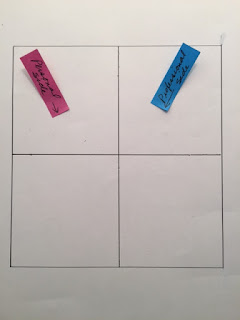Parents, take notes at lessons!
I go on and on about the importance of this, and still, it seems that parents have trouble with this advice. When I started out as a young teacher, I used to think the following questions to myself about this problem:
- Do parents not understand how important note taking is at the lesson?
- Do parents not realize that teachers have to steal lesson time in order to be sure that clear instructions and notes are put in the assignment book?
- Do parents think that the teacher will leave thorough assignments when rushed for time to complete the lesson before the next student enters the room?
- Do parents want the teacher to write skimpy notes about what happened during the lesson?
- Do parents truly believe that the parents will remember everything that happened at the lesson and what the teacher expects to happen at home during practices?
Oh, I was so naive and young when I thought those questions. So arrogant and inexperienced. Today I look back and shudder at those questions. I do not really know what parents think. I hope that parents have taken my advice and are taking notes. Unfortunately, I do not always see evidence of this even in my own studio. I often wonder why this is. I know that many parents listen to my podcast (
episode 6: How to Take Notes at the Music Lesson) and read the articles on my blog (
10 Rules for Success for Suzuki Parents), and yet, I still find parents wandering into the next room and leaving me alone to handle the recording of lesson information and practice instructions.
I have a cluttered memory when it comes to what happens during a lesson. I find it very difficult to remember every step that I took during the lesson because I am quite busy thinking and evaluating and anticipating what the student will do, can do, and will struggle to do. I have not left much room in my head to remember all the steps that I took to reach my ultimate teaching place, and I would welcome help from an observer.
So I conclude that parents most likely do not understand how to take notes. Let me offer an easy solution, and one that parents may find to be quite popular. Let me suggest that parents start a bullet journal for note taking at lessons. Here is how it would work. I broadcast an entire episode about this subject, and you may find this podcast episode to be a great companion to this article, and vice versa (
Episode 42: The Bullet Journal and Other Tools).
I use a Leuchtturm 1917 medium dotted notebook for my own bullet journal needs:
These journals come in many different prices and color choices. The one pictured here is one of the lowest prices right now (typically the usual price as well). This is perhaps the most popular choice for bullet journals right now, although some folks prefer moleskin notebooks, such as:
The original bullet journal concept was created by Ryder Carroll and you can find more information about how to use a bullet journal in general at
www.bulletjournal.com. There are many videos and Pinterest boards that provide more information. There is a Facebook group about minimalist bullet journaling too. And, Pinterest and Instagram material abounds!
For my purpose here, a basic bullet journal is all that is necessary, although I myself use one pretty extensively. My purpose here is to show parents how simple note taking can be at a lesson with a bullet journal. Perhaps a parent will be able to use the bullet journal for other needs, but for now, a bullet journal for lesson note-taking may be all that a parent needs.
Step one: open up the journal and set up a few necessary pages.
- Index: this is generally the first 3 pages of the journal. The Leuchtturm journal comes with a preprinted index.
- Future Log: After the index, turn to the first two pages that are blank. Count the number of rows on the page and divide by 3. Count down that number of rows (1/3 of the rows on the page) and draw a horizontal line across the entire two-page spread. Draw another line 1/3 of the way down the page. When you finish drawing the lines, you will have 6 quadrants. Now label each quadrant as a month. If you start this journal in January, you will now have January through June months represented in this future log. You can start a future log anytime, not just in January. Now note important information in the appropriate month of the future log. Include such things as the dates of group classes, studio recitals and performances, and other special notes, such as holiday breaks.
- Monthly Log: Although I do not personally use a monthly log very much because I prefer a regular calendar planner for the detailed appointment lists, I do maintain 1-2 pages for a month, and I use these pages as a brain dump of things that I need to do in that month. I just list anything that I want to do this month on those two pages. I put an open square to the left of the item, and as I complete these items, I will fill in the square. If it is an appointment, then I draw an open triangle to the left of the item and fill it in. I use my monthly logs as a place to capture thoughts that occur to me about things that I need to accomplish in the month.
- Weekly Log: For me, this is the most useful part of my bullet journal. I have a weekly spread that I prefer to use, but there are many different ways, and the fun thing about bullet journals is that you can change how you use it every week, or even every day. As a teacher, I use the weekly log to help me plan and control how my week's workload unfolds. I keep track of my appointments and things to do. I maintain a list of my top three things to accomplish in the week, and I keep track of things that I am waiting for (people I have emailed, packages that I expect, or phone calls that I anticipate receiving). I also have a habit tracker in one corner of my weekly log and another little corner where I can note important items or events that will occur in the future, such as the following week.
- Daily Logs: I do not use daily logs in my journal, but I suggest that this would be a useful tool for students and parents. I have written before about the benefits of using a practice journal, and since the advent of the bullet journal phenomenon, I think that bullet journals would be the best tools for this. I do use a page spread called a "time ladder." This spread sets out a day by the hour, and there is room on one side for appointments and the other side for things accomplished or planned. And the beauty of such a layout is that if you run out of room, you can draw a line to indicate the appropriate hour that the activity or event occurs.
- Other Spreads: There are other possibilities for the bullet journal as well. Here are a few ideas:
- tracking practice challenges, such as 100 days
- tracking lists of supplies
- tracking instrument maintenance
- goal-setting
- names and contact information of classmates and other parents
- lists of music and recordings to purchase
I have one other suggestion to make, and that is to use a lot of color in the bullet journal. I have seen some amazing artwork done in the bullet journals that I have seen on Pinterest and YouTube. I myself do not have the time or patience to practice such things, and so I use erasable color pens. I highly recommend these pens because you can erase mistakes! I love the color splashes in the journal, and I change colors all the time to suit my mood.
How to Take Notes at Lessons with a Bullet Journal
Now, here is how parents can use the bullet journal to take notes. I suggest that parents use the weekly log and the daily log. The weekly log would be helpful to plan practices in advance. With my own weekly logs, I can see at a glance how busy my days will be, and I can plan appropriately to suit my weekly schedule.
The daily log would be the heart of a parent's note-taking. As practices progress, parents could note everything that occurred during a practice, along with observations about difficulties and suggestions for what to practice the next session. These daily sections could be as short or as long as the parent needed them. They also provide a written record that could be shown to the teacher or referred to as needed at lessons.
At lessons, the parent could start a special two page spread that would list everything that occurred during the lesson. I suggest bullet points to set apart each item or action that occurred during the lesson. If there was something that happened that was important and needed special attention later, use a special signifier such as an asterisk or an exclamation point instead of a bullet point to set apart the item.
This spread could also include anything that occurred to the parent during lessons, such as questions or other thoughts. The teacher could also include notes on these pages for the parent as well.
The bullet journal is a simple tool and a very useful one. Many people rely on this tool to help them stay organized with their lives. I suggest that parents would find this tool to be quite simple for keeping track of the information that comes from their children's music lesson experiences.
Please comment to let me know how this tool works for you. If you are already a seasoned bullet journal user and have some suggestions to make, please let me know about it. I will post pictures of these various spreads in the next posts to come, so stay tuned!
Happy Practicing!
----- Paula -----
© 2017 by Paula E. Bird





















